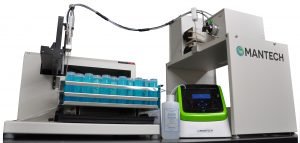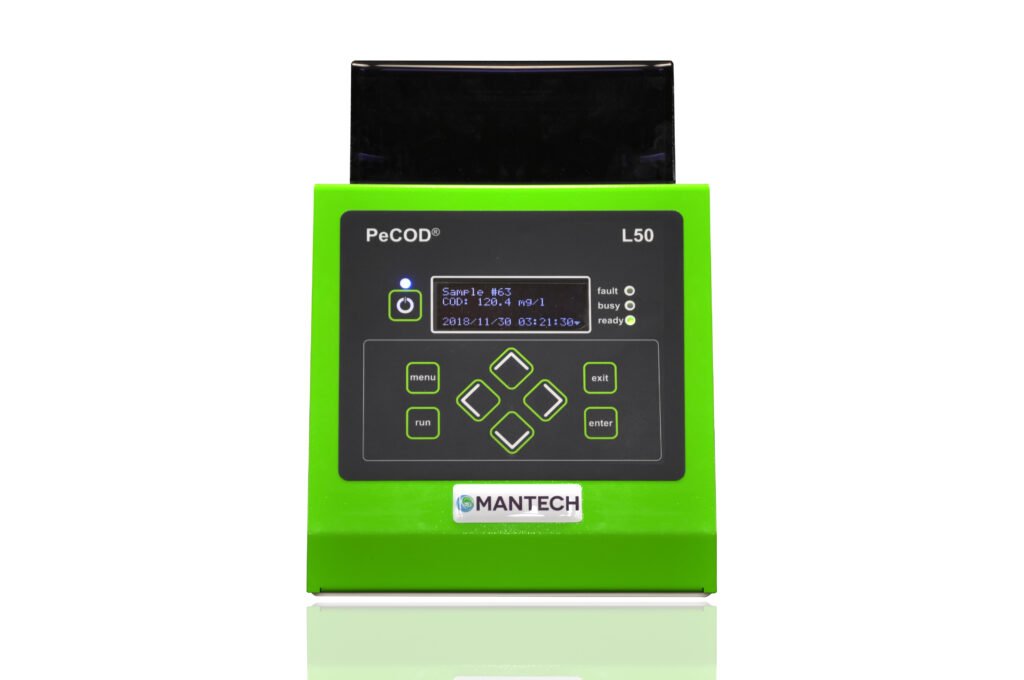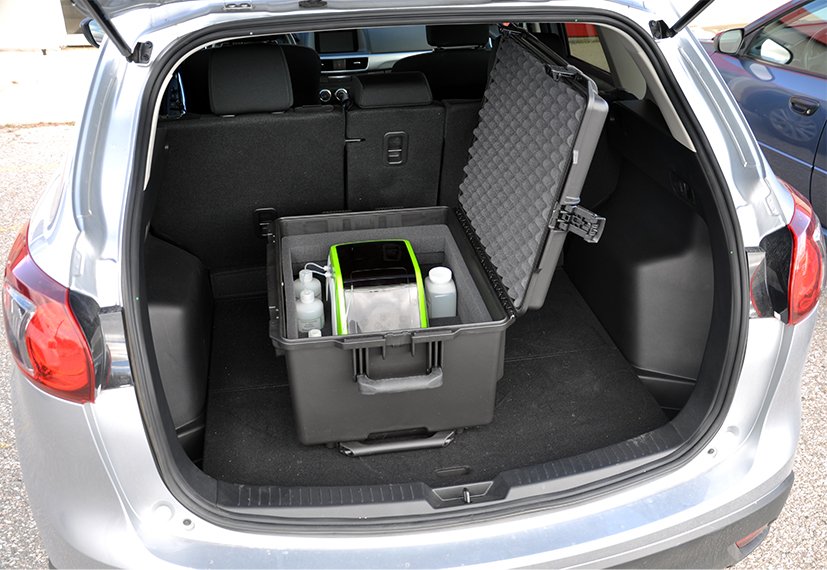Fast, green, accurate Chemical Oxygen Demand analysis
Water and Wastewater Analyzers


PeCOD L50
The Benchtop L50 PeCOD® COD Analyzer for use in industrial, municipal and academic lab settings.

Automated L100 PeCOD
The Automated L100 PeCOD® COD Analyzer provides unattended analysis for a large number of samples.

L100 Online PeCOD
The Online L100 PeCOD® COD Analyzer will automatically grab samples from a low flow line or wastewater tank, at scheduled time intervals.
PeCOD COD Analyzer
MANTECH’s revolutionary PeCOD® COD Analyzer technology provides accurate chemical oxygen demand (COD) results in 15 minutes — without the use of harmful chemicals including dichromate and mercury.
Highly adaptable for wastewater and drinking water applications, the PeCOD® COD Analyzer’s patented nanotechnology-based approach to COD analysis will save you time and money while protecting the environment and the health and safety of your workers.
The PeCOD® COD Analyzer is available in laboratory, portable and online configurations that are highly customizable. The peCOD system can be configured to accommodate laboratory operations, automated sampling, or continuous process monitoring.
Faster, accurate results
peCOD is the fastest available method for quantifying chemical oxygen demand (COD), providing operators with real time data needed to make timely, impactful decisions that enhance environmental protection while generating substantial savings on chemical and energy use.
Safe, green chemistry
peCOD nanotechnology provides a higher oxidizing power and none of the risks associated with harmful chemicals such as dichromate and mercury used in traditional COD analysis. It’s safe and simple to use for any laboratory or operations staff member at any point in the process.
The core of the technology is the peCOD sensor, which consists of a UV-activated nanoparticle TiO2 (titanium dioxide) photocatalyst coupled to an external circuit. When a sample is introduced into the microcell containing the peCOD sensor, the TiO2 is irradiated by UV light, and a potential bias is applied. The UV light creates a photohole in the TiO2 sensor with a very high oxidizing power and organics in the cell are oxidized. peCOD is extremely accurate across a broad range of organics. The powerful oxidizing potential of UV-illuminated TiO2 ensures that virtually all species will be fully oxidized giving a true measure of COD.
Strong correlation to BOD5
The PeCOD® COD Analyzer technology is a proven performer in a variety of municipal and industrial wastewater applications. Recent studies have shown a strong correlation between the 15 minute peCOD method for testing chemical oxygen demand (COD) and standard dichromate COD (CODCR) and five-day BOD (BOD5) methods. In most cases, peCOD can be used as a BOD screening tool, providing accurate BOD estimates in just minutes versus several days.
Trusted by governments
The PeCOD® COD Analyzer will be the technology of choice as new regulations take effect in Europe in September 2017 that will eliminate the use of dichromate in COD testing. peCOD conforms to Method E3515, released in 2014 by the Ontario Ministry of Environment and Climate Change (MOECC) to replace the dichromate method for COD testing. peCOD is also included as an approved alternate COD method in the Protocol for the Sampling and Analysis of Industrial/Municipal Wastewater which was updated in 2016 by the MISA (Municipal Industrial Strategy for Abatement) program.
One technology, multiple configurations
The PeCOD® COD Analyzer is available in a variety of configurations that use the same innovative technology and method. peCOD combines robust performance and flexibility to suit the needs of your laboratory or process operations.
Industrial & Municipal Wastewater
In a research project supported by the Ontario Clean Water Agency (OCWA) and the Region of Peel, MANTECH put its photoelectrochemical Chemical Oxygen Demand (peCOD) method to the test in real-world conditions at a Wastewater Treatment Facility near Mississauga, Ont.
An abstract of key findings from that project was presented at the 2017 Water Environment Association of Ontario (WEAO) annual conference in Ottawa.
The study demonstrated that the real time data provided by MANTECH’s PeCOD® Analyzer enables municipal wastewater treatment operators to make quick decisions that enhance environmental protection and generate substantial savings on chemical and energy use.
PeCOD® technology is well-suited for use by industrial wastewater treatment facilities that demand fast, reliable results and easy-to-use systems for treating bulk wastewater from multiple industries including automotive, steel, chemical and dairy facilities.
In a recent study, the PeCOD® Analyzer was deployed by a Clean Harbors Canada’s industrial wastewater facility in Guelph, Ont. The plant uses heavily refined chemical precipitation processes to remove heavy metals, suspended solids and organics to generate safe effluent for discharge into the municipal water treatment system.
Results of the study showed a strong correlation between the green, 15-minute peCOD method for testing chemical oxygen demand (COD) and standard dichromate COD (CODCR) and five-day BOD (BOD5) methods. By providing real time COD analysis and reliable BOD estimates, PeCOD® has helped Clean Harbors save money and increase profits while improving workplace health and safety by eliminating the use of dichromate, mercury and concentrated acid required by standard testing methods. To learn more, read the case study.
Pulp & Paper
The PeCOD® Analyzer was used to evaluate the effects of advanced oxidation watertreatment technologies at various stages of the pulp and paper wastewater treatment process. Results of the study demonstrate that peCOD is a valuable tool for optimizing plant operations and water treatment.
A Chilean pulp and paper company has been using a PeCOD® Analyzer from MANTECH in full-scale operations since 2013. As a result, they have reduced the use of hypochlorite in their bleaching processes with no loss of product quality, and decreased the amount of organics in the wastewater stream. The net result was a further reduction in chemicals and energy used in water treatment that saved the company US$3 million in the first year. To learn more, read the case study.
Food & Beverage
In 2015, MANTECH’s PeCOD® Analyzer was selected to provide water quality analysis for three pilot projects examining water and wastewater testing in Ontario’s food and beverage industry. Supported by The Bloom Centre for Sustainability, the study looked at the potential of new real time chemical oxygen demand (COD) methods for saving processors time and money by providing them with a continuous picture of what is going on in their wastewater systems.
For the project, MANTECH’s PeCOD® Analyzer was installed at a winery, a brewery and a bakery to provide real time measurements and analysis of wastewater effluent at each facility. The analyzers automatically collected and tested samples at each facility over a four- to six-week period. The data was compared to a second set of samples collected at each site and sent to a laboratory for independent COD and BOD testing.
The result: tests confirmed that the real time capabilities of the PeCOD® Analyzer can be used to provide accurate BOD estimates within 15 minutes, compared to the five-day turnaround for traditional BOD testing. The pilot projects demonstrated that real time COD can be used to improve water and wastewater management in the food and beverage sector. Read the case study to learn more.
Drinking Water
MANTECH and researchers at the University of Toronto are testing the PeCOD® Analyzer for drinking water system in a pilot project supported by the Southern Ontario Water Consortium’s (SOWC) Advancing Water Technologies (AWT) program and the Federal Economic Development Agency for Southern Ontario.
The 10-month long project that got underway in 2016 is testing the peCOD method at a water treatment plant in Peterborough, Ont.
In another project planned for 2017, MANTECH has joined University of Massachusetts researchers examining disinfection byproducts found in drinking water systems in New York City, Philadelphia and Portland, Maine.
PeCOD® technology has also been a key component of ongoing research at Dalhousie University’s Centre for Water Resources Studies. peCOD has been used in several research projects to monitor source and treated drinking water in Nova Scotia as well as wastewater in northern communities. Read more.
“The PeCOD® has been able to give our group additional insight into drinking water biofiltration performance by quantifying organic matter removal across biofilters that was largely unrealized by measuring dissolved organic carbon alone. PeCOD® is now being integrated into many of our projects that require a measurement of natural organic matter.” — Centre for Water Resources Studies
Research and Laboratory
Laboratory staff have known for a long time about the potential negative health impacts and safety dangers of the standard “dichromate method” for COD analysis, even the European Union REACH regulation has banned dichromate effective 2017. Any level of dichromate, no matter how it is packaged or handled, still represents a danger. PeCOD® does not use harmful dichromate for COD analysis. Leading laboratories are converting to PeCOD® COD analysis to protect the health and safety of their staff, students and the environment.
PeCOD® COD technology is used around the world in a wide variety of settings, including:
- College laboratories
- University laboratories
- Government Enforcement Agencies
- Government Regulatory Agencies
“Our Annacis Research Centre researchers have remarked that PeCOD® produces results very quickly, which allows them to complete research more rapidly. They have also been impressed with the fact that it doesn’t use harmful chemicals, reducing safety risks to researchers and to the environment. They have also found that the PC Titrate equipment is very effective. It gives extremely accurate results, is well designed, and works automatically, saving researcher time. We are thankful to the University of British Columbia and MANTECH for the donated equipment, and look forward to its role in advancing research in the region.” Jeff Carmichael, Director, Annacis Research Centre
Introduction to the PeCOD® L50 COD Analyzer.
Download the brochures for Wastewater and Drinking Water applications.
Download the brochure for Online L50 PeCOD Analyzer.
Download the application summaries for Petrochemical and Pulp & Paper.
Download PeCOD Pro™ Software for Benchtop L50.
Download PeCOD® L50 Technical and General Specifications.
COD Models and Specifications
L50 PeCOD COD Benchtop Analyzer
The Benchtop L50 PeCOD® COD Analyzer is MANTECH’s base model for use in industrial, municipal or government and academic lab settings.
NOTE: The L50 is a direct replacement for the L100
System Benefits:
- Small footprint (280 x 210 mm, 11.00 x 8.25 in)
- Lightweight (7 kg, 15.5 lb)
- MANTECH’s PeCOD Pro™ software adds automation and a sleek user interface
- Can be upgraded to Automated or Online systems
L50 PeCOD COD Portable Analyzer
* Discontinued L100 model displayed
The world’s fastest method for chemical oxygen demand (COD) analysis is also available in a portable field unit. Just add the battery and carrying case and COD can be measured in the field without the need to transport toxic or hazardous reagents.
System Benefits:
- Small footprint (508 x 355.6 x 609.6 mm, 20 x 14 x 24 in)
- Convenient case with wheels (weighs approximately 16 kg, 35 lb with analyzer & supplies)
- No sample digestion is required, making it a truly portable technique
- MANTECH’s PeCOD Pro™ software adds automation and a sleek user interface
Automated L100 PeCOD COD Analyzer
* Discontinued L100 model displayed
The Automated L100 PeCOD® COD Analyzer provides unattended analysis for a large number of samples.
System Benefits:
- Unattended, continuous analysis of 73 samples
- System is pre-calibrated before the start of each work day
- Additional parameters can be added on, including pH, EC, alkalinity, BOD and turbidity
L100 Online PeCOD® COD Analyzer
* Discontinued L100 model displayed
The Online L100 PeCOD® COD Analyzer will automatically grab samples from a low flow line or wastewater tank, at scheduled time intervals.
System Benefits:
- Save time and money through process optimization with real time COD results
- Option to add automated pH adjustment and dilutions
- Additional parameters can be added on, including pH, conductivity, alkalinity, and ammonia

